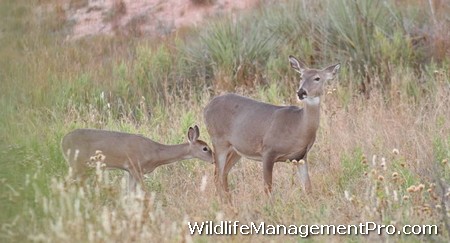The key to long-term health for white-tailed deer and other wildlife populations involves habitat management. Biologists interested in deer management have long know that it takes good habitat, which includes high quality foods and adequate cover, to maintain healthy animals. In many areas, the plant communities may be of little value to animals such as deer, but habitat management practices can be implemented to create just what they need.
Prescribed burning is an effective method of increasing the abundance and improving the quality of white-taied deer forage in old fields and pine-dominated woodlands. Additionally, prescribed fire is an excellent timber management tool. On most sites, deer forage is increased by burning small blocks of woodlands on a 3-5 year cycle. This is attained by burning about one-fifth to one-third of all suitable areas each year.

Preferably, areas no larger than about 200 acres should be burned in any one block. For white-tailed deer management, restrict fire use to February and March. Many state agencies and private forestry and wildlife consultants can provide technical assistance to landowners who are inexperienced in prescribed burning.
Thinning and cutting extensive stands of mature timber is a great practice for managing deer habitat. Continuous tree canopies allow very little sunlight to reach the forest floor. As a result, little plant growth is found in the 0- to 4-1/2-foot range where white-tailed deer feed. Thinning or clear-cutting small blocks of timber (1/2 to 10 acres in size) opens the forest canopy and allows more sunlight to reach the forest floor. The result is that deer food abundance and availability are dramatically increased.
Logging roads and food plot margins are often good sites for cutting or thinning. The edges of these areas may be maintained in deer forage production by periodic burning or mowing (every 3 years). When thinning or cutting, try to avoid cutting down trees that are producing good deer food. Forest stands should be managed to maximize different types of food for white-tailed deer. Manage large stands of timber on an uneven-age basis so that trees of all sizes and ages occur throughout the stand. Small, even-aged stands make for good deer habitat if they are mixed in among other stands of different ages.
Food plots for deer are effective for supplementation and should be use for deer management where adequate annual rainfall occurs. Food plots are frequently planted to supplement native foods and to attract whitetail during the deer hunting season. Small grains and clovers are planted as a winter grazing source for deer. Seeds of corn, grain sorghum, beans, and peas are energy-rich foods that are suitable for food plots and are planted during the spring and summer.
Food plots should be from 1 to 5 acres in size to help ensure adequate food production and availability on properties implementing white-tailed deer management. Larger plots may be needed for summer plantings of beans or peas in areas where deer populations are high. Make sure to perform a soil test, then lime and fertilize according to recommendations. The correct lime and fertilizer is absolutely necessary for optimum food plot production, nutrient quality, and use of food plantings by deer.